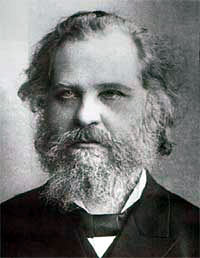<Back to Index>
- Physicist Nikolai Alekseevich Umov, 1846
- Writer Josef Kajetán Tyl, 1808
- 1st President of Germany Friedrich Ebert, 1871
PAGE SPONSOR

Nikolay Alekseevich Umov (Russian: Николай Алексеевич Умов) was a famous Russian physicist and mathematician known for discovering the concept of Umov-Poynting vector and Umov effect.
Umov was born on February 4 (N.S.) (January 23 (O.S.)), 1846 in Simbirsk (nowadays Ulyanovsk) in the family of a military doctor. Umov graduated from the Physics and Mathematics department of Moscow State University in 1867 and became a Professor of Physics in 1875. He studied theoretical physics by reading works of Gabriel Lamé, Clebsch and Clausius, that made a significant impact on the originality of his later ideas in physics.
Umov became the head of the Physics department of Moscow State University (MSU) after Aleksandr Stoletov died in 1896. Together with Pyotr Lebedev, Umov actively participated in founding the Physical Institute at the MSU.
Umov
organized several educational societies. He was the president of the
Moscow Society of Nature Explorers for 17 years. He was among the first
Russian scientists who acknowledged the importance of the theory of relativity.
In 1911, he along with a group of leading professors left Moscow
University in protest of reactionary actions by the government. Umov
died on January 15, 1915 in Moscow. Umov was the first to introduce in physics such basic concepts as speed and direction of movement of energy, which are now associated with Umov-Poynting vector, and density of energy in a given point of space. During his work in Odessa in
1873 - 1874, Umov published the first papers containing the major ideas of
energy movement. In his first works of this period, Umov considered potential energy as kinetic energy of
some environments "imperceptible for us". From this hypothesis, he draw
a conclusion: it is always possible to specify a place where the energy
is in. Therefore, it is natural to raise the question about movement of
energy. In his following works, Umov did not bind himself to this
hypothesis about the nature of potential energy, but was guided by the
principle of energy conservation only. After formulating the concept of
density and movement of energy, he formulated differential equations for
energy movement in elastic media and fluids. The fundamental
"Encyklopǎdie der mathematischen Wissenschaften” states: "N. Umov
yet in 1874 had solved a problem of the movement of energy in liquid
and elastic media in completely generalized view. However, the intense attention to this view has been attracted only after Poynting has presented a stream of electromagnetic energy based on Maxwell equations" 10 years after Umov's publications. He was the first scientist to indicate the interrelation between mass and energy proposing the formula E = kmc2 with 0,5 =< k =< 1 as early as in 1873. In
1875, Umov had solved a general problem of distribution of electric
currents in conducting surfaces of any kind. In 1888 - 1891 he
investigated experimentally the diffusion in water solutions, the
polarization of light in opaque media, and discovered the effect of
chromatic depolarization of light. In
the 1900s, he conducted a thorough analysis of many Gauss formulae
regarding terrestrial magnetism, which allowed to define secular changes of the Earth's magnetic field.